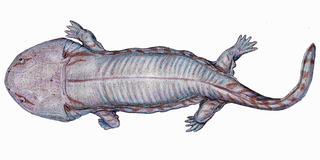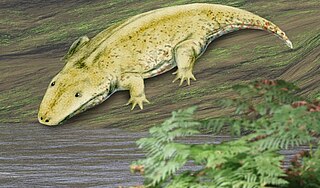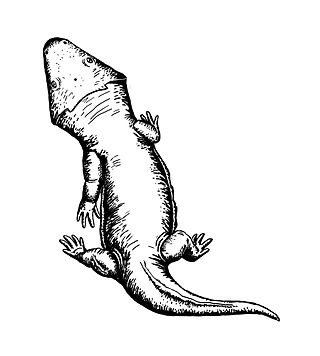
Temnospondyli or temnospondyls is a diverse ancient order of small to giant tetrapods—often considered primitive amphibians—that flourished worldwide during the Carboniferous, Permian and Triassic periods, with fossils being found on every continent. A few species continued into the Jurassic and Early Cretaceous periods, but all had gone extinct by the Late Cretaceous. During about 210 million years of evolutionary history, they adapted to a wide range of habitats, including freshwater, terrestrial, and even coastal marine environments. Their life history is well understood, with fossils known from the larval stage, metamorphosis and maturity. Most temnospondyls were semiaquatic, although some were almost fully terrestrial, returning to the water only to breed. These temnospondyls were some of the first vertebrates fully adapted to life on land. Although temnospondyls are amphibians, many had characteristics such as scales and armour-like bony plates that distinguish them from the modern soft-bodied lissamphibians.

Dvinosaurs are one of several new clades of Temnospondyl amphibians named in the phylogenetic review of the group by Yates and Warren 2000. They represent a group of primitive semi-aquatic to completely aquatic amphibians, and are known from the Late Carboniferous to the Early Triassic, being most common in the Permian period. Their distinguishing characteristics are a reduction of the otic notch; the loss of a flange on the rear side of the pterygoid; and 28 or more presacral vertebrae.

The Stereospondyli are a group of extinct temnospondyl amphibians that existed primarily during the Mesozoic period. They are known from all seven continents and were common components of many Triassic ecosystems, likely filling a similar ecological niche to modern crocodilians prior to the diversification of pseudosuchian archosaurs.

Gerobatrachus is an extinct genus of amphibamid temnospondyl that lived in the Early Permian, approximately 290 million years ago (Ma), in the area that is now Baylor County, Texas. When it was first described in 2008, Gerobatrachus was announced to be the closest relative of Batrachia, the group that includes modern frogs and salamanders. It possesses a mixture of characteristics from both groups, including a large frog-like head and a salamander-like tail. These features have led to it being dubbed a frogamander by the press. Some more recent studies place Gerobatrachus as the closest relative of Lissamphibia, the group that contains all modern amphibians including frogs, salamanders, and caecilians, or place modern amphibians far from Gerobatrachus within a group called Lepospondyli.

Euskelia is a proposed clade of extinct temnospondyl amphibians. The naming derives from the ancient Greek eu, meaning "true", and skelos, meaning "limb", in reference to well-ossified limb bones with crests to which muscles were attached.

Sclerocephalus is an extinct genus of temnospondyl amphibian from the lowermost Permian of Germany and Czech Republic with four valid species, including the type species S. haeuseri. It is one of the most completely preserved and most abundant Palaeozoic tetrapods. Sclerocephalus was once thought to be closely related to eryopoid temnospondyls, but it is now thought to be more closely related to archegosauroids. It is the only genus in the family Sclerocephalidae.

Intasuchus is an extinct genus of temnospondyl amphibian from the Middle Permian of Russia. It is known from a single species, Intasuchus silvicola, which was named in 1956. Intasuchus belongs to the family Intasuchidae and is probably its sole member, although other taxa such as Syndyodosuchus and Cheliderpeton have been assigned to the family in the past. Intasuchus most likely belongs to the group Archegosauroidea, Permian relatives of the large, mostly Mesozoic temnospondyl clade Stereospondyli.

Saharastega is an extinct genus of basal temnospondyl which lived during the Late Permian period, around 251 to 260 million years ago. Remains of Saharastega, discovered by paleontologist Christian Sidor at the Moradi Formation in Niger, were described briefly in 2005 and more comprehensively in 2006. The description is based on a skull lacking the lower jaws.

Rhinesuchidae is a family of tetrapods that lived primarily in the Permian period. They belonged to the broad group Temnospondyli, a successful and diverse collection of semiaquatic tetrapods which modern amphibians are probably descended from. Rhinesuchids can be differentiated from other temnospondyls by details of their skulls, most notably the interior structure of their otic notches at the back of the skull. They were among the earliest-diverging members of the Stereospondyli, a subgroup of temnospondyls with flat heads and aquatic habits. Although more advanced stereospondyls evolved to reach worldwide distribution in the Triassic period, rhinesuchids primarily lived in the high-latitude environments of Gondwana during the Guadalupian and Lopingian epochs of the Permian. The taxonomy of this family has been convoluted, with more than twenty species having been named in the past; a 2017 review recognized only eight of them to be valid. While several purported members of this group have been reported to have lived in the Triassic period, most are either dubious or do not belong to the group. However, at least one valid genus of rhinesuchid is known from the early Triassic, a small member known as Broomistega. The most recent formal definition of Rhinesuchidae, advocated by Mariscano et al. (2017) is that of a stem-based clade containing all taxa more closely related to Rhinesuchus whaitsi than to Lydekkerina huxleyi or Peltobatrachus pustulatus. A similar alternate definition is that Rhinesuchidae is a stem-based clade containing all taxa more closely related to Uranocentrodon senekalensis than to Lydekkerina huxleyi, Trematosaurus brauni, or Mastodonsaurus giganteus.

Lydekkerinidae is a family of stereospondyl temnospondyls that lived in the Early Triassic period. During this time period, lydekkerinids were widely distributed, with putative remains reported from Russia, Greenland, India, South Africa, Madagascar, Australia, and Antarctica. In contrast to most other stereospondyls, lydekkerinids were relatively small-bodied. The type genus is Lydekkerina, the namesake of the family and the best-known lydekkerinid.

Stereospondylomorpha is a clade of temnospondyls. It includes the superfamily Archegosauroidea and the more diverse group Stereospondyli. Stereospondylomorpha was first proposed by Yates and Warren (2000), who found Archegosauroidea and Stereospondyli to be sister taxa in their phylogenetic analysis. A similar clade is Archegosauriformes, named by Schoch and Milner (2000), which includes Stereospondyli and some Permian temnospondyls that are similar in appearance to stereospondyls, including the archegosauroids. However, according to Schoch and Milner's phylogeny, Archegosauroidea is a paraphyletic group of taxa that are successively basal to Stereospondyli, rather than a monophyletic sister taxon.

Lydekkerina is an extinct genus of stereospondyl temnospondyl. It is the type genus of the family Lydekkerinidae. Fossils have been collected from Early Triassic deposits in South Africa and Australia. The type species is L. huxleyi, first described in 1889. While most other stereospondyls were semiaquatic, Lydekkerina was exclusively terrestrial.

Lapillopsis is an extinct genus of stereospondyl temnospondyl within the family Lapillopsidae. Fossils belonging to the genus have been found in the Arcadia Formation of Queensland, Australia.

Rhineceps is an extinct genus of temnospondyl amphibian in the family Rhinesuchidae. Rhineceps was found in Northern Malawi in Southern Africa known only from its type species R. nyasaensis. Rhineceps was a late Permian semi-aquatic carnivore that lived in streams, rivers, lakes or lagoons. Rhineceps is an early divergent Stereopondyl within the family Rhinesuchidae, which only existed in the late Permian (Lopingian) and failed to survive the Permian-Triassic extinction unlike other stereospondyl families.
Rileymillerus is an extinct genus of temnospondyl amphibian from the Late Triassic Post Quarry in the Dockum Group of Texas that was described by John Bolt and Sankar Chatterjee in 2000. The holotype, a nearly complete skull with articulated jaws, is housed at the Museum of Texas Tech University. The genus is named for Riley Miller, who allowed Chatterjee to work on the Post Quarry, and the species is named for the paleontologist John Cosgriff.

Rhytidostea is a clade of stereospondyl temnospondyls. It was erected in 2000 to include several temnospondyl groups distinct from the "higher" group of capitosaurs, including lydekkerinids, brachyopoids, and rhytidosteids. Rhytidosteans first appeared in the Permian period and underwent an evolutionary radiation during the Induan stage of the Early Triassic. Along with capitosaurs, rhytidosteans comprise much of the larger suborder Stereospondyli. Rhytidostea has often been considered the sister group of the clade Capitosauria, but has been placed in various other phylogenetic positions. In many studies, members of Rhytidostea are split, with lydekkerinids having a more basal position among stereospondyls while rhytidosteids and brachyopoids form a group placed among the more derived trematosaurian stereospondyls.

Derwentiinae is a subfamily of rhytidosteid temnospondyls from the Permian and Triassic periods of Australia and India. It includes the genera Arcadia, Deltasaurus, Derwentia, Indobrachyops, and Rewana. Derwentiinae was named in a 2011 study that analyzed the phylogenetic relationships of rhytidosteids. It was a replacement name for the family Derwentiidae, which was named in 2000.

Vigilius is an extinct genus of brachyopid temnospondyl amphibian from the Triassic of Arizona. It is known from the single type species Vigilius wellesi.

Rhachitomi is a group of temnospondyl amphibians that includes all temnospondyls except edopoids and dendrerpetontids. It was established as a clade name by German paleontologist Rainer R. Schoch in 2013, although the name had first been established in 1919 by British paleontologist D. M. S. Watson to encompass an evolutionary grade of temnospondyls leading to the group Stereospondyli. American paleontologist Alfred Romer used the term in a similar sense, grouping most Permian and Triassic temnospondyls under Rhachitomi. A similar name that appeared earlier in the scientific literature is Rachitomi, which was named by American paleontologist Edward Drinker Cope in 1882. Rachitomi was commonly used in the late nineteenth and early twentieth century to include early amphibians such as Eryops and Archegosaurus that had rhachitomous vertebrae. Many early tetrapods have vertebrae that are split into two parts below the notochord: a pleurocentrum and an intercentrum. In rhachitomous vertebrae, the intercentrum is large and semicircular, while the pleurocentrum divided into two smaller paired elements. Schoch defined Rhachitomi as a node-based taxon to include four major and well-supported clades of temnospondyls: Dvinosauria, Eryopidae, Stereospondyli and a clade formed by Zatracheidae and Dissorophoidea. Not all members of Rhachitomi have rhachitomous vertebrae; the largest subgroup, Stereospondyli, lacks pleurocentra. Below is a cladogram from Schoch's analysis showing the placement of Rhachitomi within Temnospondyli:

Manubrantlia was a genus of lapillopsid temnospondyls from the Early Triassic Panchet Formation of India. This genus is only known from a single holotype left jaw, given the designation ISI A 57. Despite the paucity of remains, the jaw is still identifiable as belonging to a relative of Lapillopsis. For example, all three of its coronoid bones possessed teeth, the articular bone is partially visible in lateral (outer) view, and its postsplenial does not contact the posterior meckelian foramen. However, the jaw also possesses certain unique features which justify the erection of a new genus separate from Lapillopsis. For example, the mandible is twice the size of any jaws referred to other lapillopsids. The most notable unique feature is an enlarged "pump-handle" shaped arcadian process at the back of the jaw. This structure is responsible for the generic name of this genus, as "Manubrantlia" translates from Latin to the English expression "pump-handle". The type and only known species of this genus is Manubrantlia khaki. The specific name refers to the greenish-brown mudstones of the Panchet Formation, with a color that had been described as "khaki" by the first British geologists who studied the formation.






















